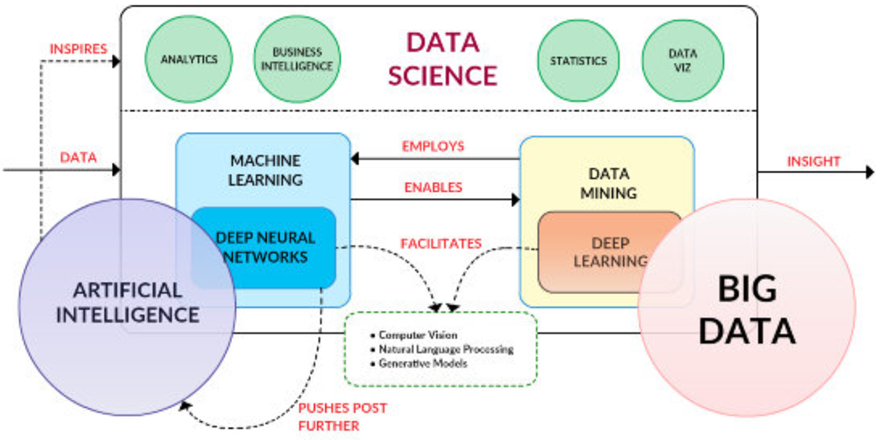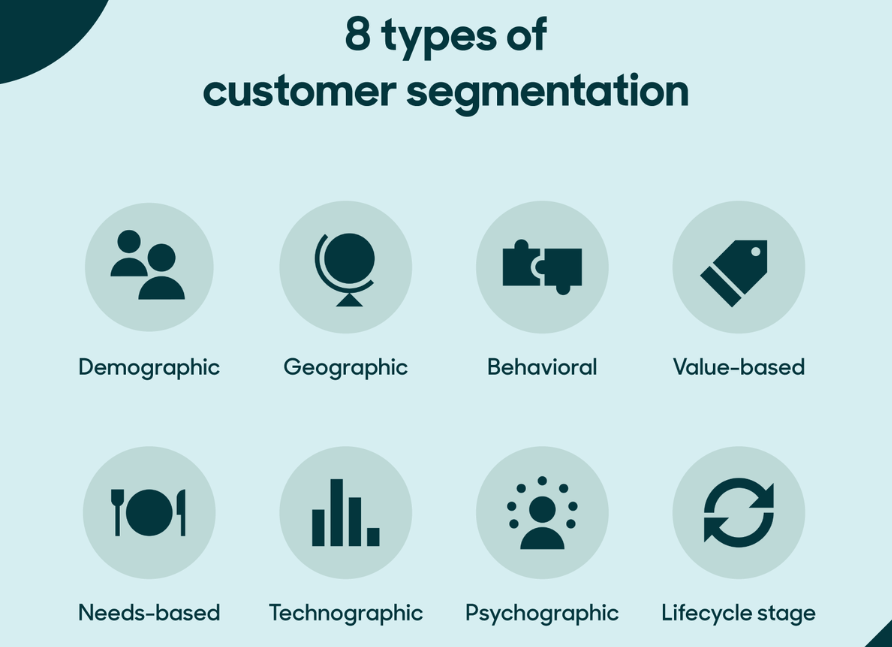Data science has completely revolutionized how we do business today, and in some cases, the business insights offered by data science have encouraged companies to modernize their workflows, so that various data points can be better tracked. Nowhere is this more apparent than in retail. The retail supply chain is complex, and many of its key interactions used to be documented with analog mechanisms. But with the influx of new technology, it has become easier to produce raw data that can generate actionable insights for brands in the retail industry.
Today, data science has made a mark on just about every aspect of retail businesses, including marketing strategy, supply chain management, digital transformation processes, and much more. In this article, we’re going to take a look at specific use cases where data science has upended traditional approaches and produced meaningful insights for the retail industry.
Is Data Science Common in Retail?
Very few serious retail businesses make big decisions without considering insights yielded by data science. Whether it’s designing the checkout for e-commerce sites or building a collaborative filtering system, data science informs major decisions that are being made.
13 Data Science in Retail Use Cases and Examples
Data science is now a major part of large retail businesses. Let’s take a look at the areas where data is used to gain deeper insights and make informed decisions in the retail industry.
Behavior Analytics

Understanding customer behavior is essential to running a retail business. Data obtained from various sources can be collated to paint a surprisingly accurate picture of customer demands, customer satisfaction, and other granular behavioral markers. This area of study is known as behavioral analytics.
Example
Let’s say that you run an e-commerce website selling home improvement tools. You want to design your site so that visitors quickly navigate from the home page to specific product pages.
Behavior analytics can help you achieve that. You can use data obtained from tracking tools on your website to gauge what kinds of images and copy entice clicks from visitors. Further, you can use data on website visitors to build segments and serve up different kinds of homepage layouts depending on their different behaviors on your website.
Customer Experience

Data science helps retailers demystify their customers’ decisions and behaviors. That has helped companies increase customer engagement and as a result, customer retention.
Example
Say you have an e-commerce store selling cell phones, with a built-in feature where customers can raise complaints. One way you can go about providing a better customer experience is by analyzing these. You would start by classifying the issues into categories such as:
- Delivery issues
- Hardware/device issues
- Software issues
- Returns, and so on
You can then enlist the help of machine learning techniques to build a sentiment analysis tool. This would tell you which of your customers’ problems are causing the greatest deal of distress, which can then help you address their most pressing issues, and thereby increase overall customer satisfaction.
Trend and Sales Forecasting

One of the most common applications of data science in retail is forecasting demand. Knowing which way the market is trending can be a powerful advantage, and help both boost sales and guide product launches.
Example
You run a retail business and want to know what the best time of the year to give out discounts is. Demand forecasting can come in handy with such an undertaking.
You would start by examining historical sales data. This would give you an idea of the times of the year when sales are high and when they tend to slump. Say you notice a drop in sales right after the winter holidays. You could use that information to provide your customers with discounts in January, thereby increasing sales in an otherwise slow time of year.
Recommendation Engines

Building a strong recommendation engine is integral to success in online retail, as providing personalized recommendations is one of the best ways to drive sales. Data, of course, plays a huge role in how you go about building a recommendation engine.
Example
Imagine you run an e-commerce website and want to build an engine that offers personalized recommendations. To do this, you would build a system that tags your products based on specific characteristics, and also creates user segments based on their preferences.
Now let’s say that Visitor A just bought an iPhone. What is he most likely to want to buy next? Your recommendation engine might determine that members of Visitor A’s cohort usually buy an iPhone case next. So it would recommend that, which has a lot higher likelihood of driving a sale.
Customer Segmentation

Grouping customers into segments helps you create tractable categories, and create targeted messages to drive sales.
Data science can help create these customer segments by determining which characteristics are the most salient to group customers. You can then identify individual customers based on those markers and add them to relevant cohorts.
Example
It is very common in retail to create customer segments based on how many interactions a customer has had with your business. You can use these segments to target each group with the right kind of messaging based on the stage of the customer journey that they’re in.
First-time buyers, for example, would constitute one segment. This is a group that you would target with information on the brand, loyalty programs, and email capture forms.
Conversely, long-term, loyal customers would also constitute their own cohort. These customers are already believers in your brand and would be the ones you turn to when you have new product launches or are experimenting with products or messaging in some way.
Inventory Management and Optimization

Every retailer understands that their physical space is limited and that managing inventory levels effectively is essential for success. Data science can help with both inventory management and optimization for retail businesses. You can use it to study your warehousing capabilities, identify inventory trends over time, and enhance picking and packing processes in a warehouse setting.
Example
Say you’ve been dealing with inventory issues during specific times of the year. You know that there’s going to be an increased demand, but you’re never quite able to have the right inventory for those periods.
Data science can help ameliorate such an issue. You would start by studying historical sales data to determine which SKUs are most in demand at different times of the year. You can also see if there are inventory items that have become obsolete or low-performing during a particular time. You can combine these pieces of information to optimize your stock intake and manage your inventory more efficiently.
Price Optimization

Thinking of the pricing of a product as a one-and-done thing is an archaic practice in the world of retail. The most successful retailers today use data science to dynamically alter the pricing of their products based on a whole host of factors.
Example
Say you’re about to introduce a new product and want to know how to price it. Nowadays, retailers use data science to create demand functions, which help establish a relationship between the price of the product and the forecasted demand for it. Logistic regression, a data analysis technique, is often used to do this.
Once you have the demand function, you can determine a price that maximizes your profits. This process is often repeated at later stages to review the price of a product, especially once competition comes into the market.
Competitor Analysis

It’s no secret that retailers snoop on each other every now and then—you want to know your competition. Competitor analysis has become supercharged with the advent of data science and its ability to unearth insights from erstwhile indecipherable data.
Example
Say there’s a new player in your sector, and you want to know whether their buzz is increasing their market share. You can use data science to build a share-of-voice analysis by factoring in a whole host of social media KPIs.
You could do this by identifying the KPIs that you deem most important, and seeing how yours stack up against the competition. You might look at things like Twitter mentions, post impressions, new follower rates, and so on. You can then compare all these data points using data analysis techniques to accurately determine how the new entrant is fairing in the market.
Targeted Promotions

Promotions and discounts are a tried-and-tested method to boost sales in retail. Data science can help with creating compelling targeted promotions and measuring the results of each campaign.
Example
One of the challenges of creating targeted promotions is knowing how to target your customers. Should you target them based on their geographical location? Is it better to target them based on their income levels?
Data science can help you answer these questions. Simple A/B tests which target users based on different parameters can give you insights into how to segment your users when you’re creating a promotion. For example, you might find that targeting users based on their age and demographics is a much better way to create promotions rather than on the basis of psychographic attributes.
Customer Lifetime Value (CLV)

The only way to become a truly successful retailer is to find a way to turn new customers into long-term patrons who make regular purchases. There are several ways in which data science can help you achieve this, including customer churn predictions, market segmentation, and purchase predictions.
Example
Data science can help predict when different customers are most likely to make their next purchase. This can be achieved through data wrangling, then using machine learning models to make accurate predictions.
Once you have these findings, you can do things to increase the lifetime value of your customers. For the customers who are highly likely to make another purchase within the next week, for example, you don’t need to provide them with discounts or coupons. You can simply nudge them with an email.
But you also know which customers are less likely (but still inclined) to make another purchase so soon. In this case, you can send them customized discounts to maximize their lifetime value.
Fraud Detection

Fraud analysis has become a highly specialized area within the field of data science. Professionals with expertise in this field are deployed across various industries, including insurance, finance, and retail.
Example
Say that your e-commerce brand tends to have a lot of cases of chargeback fraud. In that case, you can employ data science techniques to identify cases where such fraud is most likely and deal with it proactively.
One of the ways you can achieve this is by maintaining a database of various customer characteristics, such as their phone number, location, product preferences, purchase frequency, and so on. This data can help you create segments of customers among whom fraudulent chargebacks are more likely. Maintaining such a database will ensure that you flag only instances where fraud is likely and don’t interfere with the customer experience of loyal patrons.
Predictive Maintenance

Predictive maintenance is a subset of data science that uses predictive analytical techniques to preempt when maintenance might be required. This can be applied both to the maintenance of physical warehouse components and software like websites and native applications.
Example
It is not uncommon for retailers to use specialized equipment to either manufacture or store their products. Predictive maintenance can help ensure that you reduce downtime in your operations and enhance your operational effectiveness.
One way to do this is with the help of IoT devices. These devices have sensors that can detect faults or cracks in equipment. You can combine the data from these devices with analytical approaches to predict when your warehouse or manufacturing equipment will require maintenance.
Better Decision-Making

The ultimate goal of data science is to help people make better decisions. There are several ways in which retail leaders can deploy data science to help them make better decisions.
Example
One of the most common questions retail companies ask themselves is, “Where can we find new customers?” Data science can play a big role in answering this.
Any new market segment can be vetted using data. Say that you want to start targeting women aged 24 to 30. You can collect data from various sources, including social media, competitors, and surveys, to determine whether your products are likely to do well in this segment.
Get To Know Other Data Science Students
Nick Lenczewski
Data Scientist at Ovative Group
Jonah Winninghoff
Statistician at Rochester Institute Of Technology
Garrick Chu
Contract Data Engineer at Meta
FAQs About Data Science in Retail
We’ve got the answers to your most frequently asked questions:
Why Is Data Science Important in Retail?
Data science has the ability to inform decision-making in every aspect of running a retail business. Employing data science allows you to identify operational inefficiencies, come up with strong solutions to problems, and increase your profits from sales.
Do Retail Companies Need Data Science To Succeed?
Yes, retail companies need data science to succeed in today’s world. Most companies already use data science to help them make decisions backed by data. You’re at a huge disadvantage if you don’t use data science to bolster the work that you do as a retail company.
Companies are no longer just collecting data. They’re seeking to use it to outpace competitors, especially with the rise of AI and advanced analytics techniques. Between organizations and these techniques are the data scientists – the experts who crunch numbers and translate them into actionable strategies. The future, it seems, belongs to those who can decipher the story hidden within the data, making the role of data scientists more important than ever.
In this article, we’ll look at 13 careers in data science, analyzing the roles and responsibilities and how to land that specific job in the best way. Whether you’re more drawn out to the creative side or interested in the strategy planning part of data architecture, there’s a niche for you.
Is Data Science A Good Career?
Yes. Besides being a field that comes with competitive salaries, the demand for data scientists continues to increase as they have an enormous impact on their organizations. It’s an interdisciplinary field that keeps the work varied and interesting.
10 Data Science Careers To Consider
Whether you want to change careers or land your first job in the field, here are 13 of the most lucrative data science careers to consider.
Data Scientist
Data scientists represent the foundation of the data science department. At the core of their role is the ability to analyze and interpret complex digital data, such as usage statistics, sales figures, logistics, or market research – all depending on the field they operate in.
They combine their computer science, statistics, and mathematics expertise to process and model data, then interpret the outcomes to create actionable plans for companies.
General Requirements
A data scientist’s career starts with a solid mathematical foundation, whether it’s interpreting the results of an A/B test or optimizing a marketing campaign. Data scientists should have programming expertise (primarily in Python and R) and strong data manipulation skills.
Although a university degree is not always required beyond their on-the-job experience, data scientists need a bunch of data science courses and certifications that demonstrate their expertise and willingness to learn.
Average Salary
The average salary of a data scientist in the US is $156,363 per year.
Data Analyst
A data analyst explores the nitty-gritty of data to uncover patterns, trends, and insights that are not always immediately apparent. They collect, process, and perform statistical analysis on large datasets and translate numbers and data to inform business decisions.
A typical day in their life can involve using tools like Excel or SQL and more advanced reporting tools like Power BI or Tableau to create dashboards and reports or visualize data for stakeholders. With that in mind, they have a unique skill set that allows them to act as a bridge between an organization’s technical and business sides.
General Requirements
To become a data analyst, you should have basic programming skills and proficiency in several data analysis tools. A lot of data analysts turn to specialized courses or data science bootcamps to acquire these skills.
For example, Coursera offers courses like Google’s Data Analytics Professional Certificate or IBM’s Data Analyst Professional Certificate, which are well-regarded in the industry. A bachelor’s degree in fields like computer science, statistics, or economics is standard, but many data analysts also come from diverse backgrounds like business, finance, or even social sciences.
Average Salary
The average base salary of a data analyst is $76,892 per year.
Business Analyst
Business analysts often have an essential role in an organization, driving change and improvement. That’s because their main role is to understand business challenges and needs and translate them into solutions through data analysis, process improvement, or resource allocation.
A typical day as a business analyst involves conducting market analysis, assessing business processes, or developing strategies to address areas of improvement. They use a variety of tools and methodologies, like SWOT analysis, to evaluate business models and their integration with technology.
General Requirements
Business analysts often have related degrees, such as BAs in Business Administration, Computer Science, or IT. Some roles might require or favor a master’s degree, especially in more complex industries or corporate environments.
Employers also value a business analyst’s knowledge of project management principles like Agile or Scrum and the ability to think critically and make well-informed decisions.
Average Salary
A business analyst can earn an average of $84,435 per year.
Database Administrator
The role of a database administrator is multifaceted. Their responsibilities include managing an organization’s database servers and application tools.
A DBA manages, backs up, and secures the data, making sure the database is available to all the necessary users and is performing correctly. They are also responsible for setting up user accounts and regulating access to the database. DBAs need to stay updated with the latest trends in database management and seek ways to improve database performance and capacity. As such, they collaborate closely with IT and database programmers.
General Requirements
Becoming a database administrator typically requires a solid educational foundation, such as a BA degree in data science-related fields. Nonetheless, it’s not all about the degree because real-world skills matter a lot. Aspiring database administrators should learn database languages, with SQL being the key player. They should also get their hands dirty with popular database systems like Oracle and Microsoft SQL Server.
Average Salary
Database administrators earn an average salary of $77,391 annually.
Data Engineer
Successful data engineers construct and maintain the infrastructure that allows the data to flow seamlessly. Besides understanding data ecosystems on the day-to-day, they build and oversee the pipelines that gather data from various sources so as to make data more accessible for those who need to analyze it (e.g., data analysts).
General Requirements
Data engineering is a role that demands not just technical expertise in tools like SQL, Python, and Hadoop but also a creative problem-solving approach to tackle the complex challenges of managing massive amounts of data efficiently.
Usually, employers look for credentials like university degrees or advanced data science courses and bootcamps.
Average Salary
Data engineers earn a whooping average salary of $125,180 per year.
Database Architect
A database architect’s main responsibility involves designing the entire blueprint of a data management system, much like an architect who sketches the plan for a building. They lay down the groundwork for an efficient and scalable data infrastructure.
Their day-to-day work is a fascinating mix of big-picture thinking and intricate detail management. They decide how to store, consume, integrate, and manage data by different business systems.
General Requirements
If you’re aiming to excel as a database architect but don’t necessarily want to pursue a degree, you could start honing your technical skills. Become proficient in database systems like MySQL or Oracle, and learn data modeling tools like ERwin. Don’t forget programming languages – SQL, Python, or Java.
If you want to take it one step further, pursue a credential like the Certified Data Management Professional (CDMP) or the Data Science Bootcamp by Springboard.
Average Salary
Data architecture is a very lucrative career. A database architect can earn an average of $165,383 per year.
Machine Learning Engineer
A machine learning engineer experiments with various machine learning models and algorithms, fine-tuning them for specific tasks like image recognition, natural language processing, or predictive analytics. Machine learning engineers also collaborate closely with data scientists and analysts to understand the requirements and limitations of data and translate these insights into solutions.
General Requirements
As a rule of thumb, machine learning engineers must be proficient in programming languages like Python or Java, and be familiar with machine learning frameworks like TensorFlow or PyTorch. To successfully pursue this career, you can either choose to undergo a degree or enroll in courses and follow a self-study approach.
Average Salary
Depending heavily on the company’s size, machine learning engineers can earn between $125K and $187K per year, one of the highest-paying AI careers.
Quantitative Analyst
Qualitative analysts are essential for financial institutions, where they apply mathematical and statistical methods to analyze financial markets and assess risks. They are the brains behind complex models that predict market trends, evaluate investment strategies, and assist in making informed financial decisions.
They often deal with derivatives pricing, algorithmic trading, and risk management strategies, requiring a deep understanding of both finance and mathematics.
General Requirements
This data science role demands strong analytical skills, proficiency in mathematics and statistics, and a good grasp of financial theory. It always helps if you come from a finance-related background.
Average Salary
A quantitative analyst earns an average of $173,307 per year.
Data Mining Specialist
A data mining specialist uses their statistics and machine learning expertise to reveal patterns and insights that can solve problems. They swift through huge amounts of data, applying algorithms and data mining techniques to identify correlations and anomalies. In addition to these, data mining specialists are also essential for organizations to predict future trends and behaviors.
General Requirements
If you want to land a career in data mining, you should possess a degree or have a solid background in computer science, statistics, or a related field.
Average Salary
Data mining specialists earn $109,023 per year.
Data Visualisation Engineer
Data visualisation engineers specialize in transforming data into visually appealing graphical representations, much like a data storyteller. A big part of their day involves working with data analysts and business teams to understand the data’s context.
General Requirements
Data visualization engineers need a strong foundation in data analysis and be proficient in programming languages often used in data visualization, such as JavaScript, Python, or R. A valuable addition to their already-existing experience is a bit of expertise in design principles to allow them to create visualizations.
Average Salary
The average annual pay of a data visualization engineer is $103,031.
Resources To Find Data Science Jobs
The key to finding a good data science job is knowing where to look without procrastinating. To make sure you leverage the right platforms, read on.
Job Boards
When hunting for data science jobs, both niche job boards and general ones can be treasure troves of opportunity.
Niche boards are created specifically for data science and related fields, offering listings that cut through the noise of broader job markets. Meanwhile, general job boards can have hidden gems and opportunities.
Online Communities
Spend time on platforms like Slack, Discord, GitHub, or IndieHackers, as they are a space to share knowledge, collaborate on projects, and find job openings posted by community members.
Network And LinkedIn
Don’t forget about socials like LinkedIn or Twitter. The LinkedIn Jobs section, in particular, is a useful resource, offering a wide range of opportunities and the ability to directly reach out to hiring managers or apply for positions. Just make sure not to apply through the “Easy Apply” options, as you’ll be competing with thousands of applicants who bring nothing unique to the table.
FAQs about Data Science Careers
We answer your most frequently asked questions.
Do I Need A Degree For Data Science?
A degree is not a set-in-stone requirement to become a data scientist. It’s true many data scientists hold a BA’s or MA’s degree, but these just provide foundational knowledge. It’s up to you to pursue further education through courses or bootcamps or work on projects that enhance your expertise. What matters most is your ability to demonstrate proficiency in data science concepts and tools.
Does Data Science Need Coding?
Yes. Coding is essential for data manipulation and analysis, especially knowledge of programming languages like Python and R.
Is Data Science A Lot Of Math?
It depends on the career you want to pursue. Data science involves quite a lot of math, particularly in areas like statistics, probability, and linear algebra.
What Skills Do You Need To Land an Entry-Level Data Science Position?
To land an entry-level job in data science, you should be proficient in several areas. As mentioned above, knowledge of programming languages is essential, and you should also have a good understanding of statistical analysis and machine learning. Soft skills are equally valuable, so make sure you’re acing problem-solving, critical thinking, and effective communication.
Since you’re here…Are you interested in this career track? Investigate with our free guide to what a data professional actually does. When you’re ready to build a CV that will make hiring managers melt, join our Data Science Bootcamp which will help you land a job or your tuition back!






